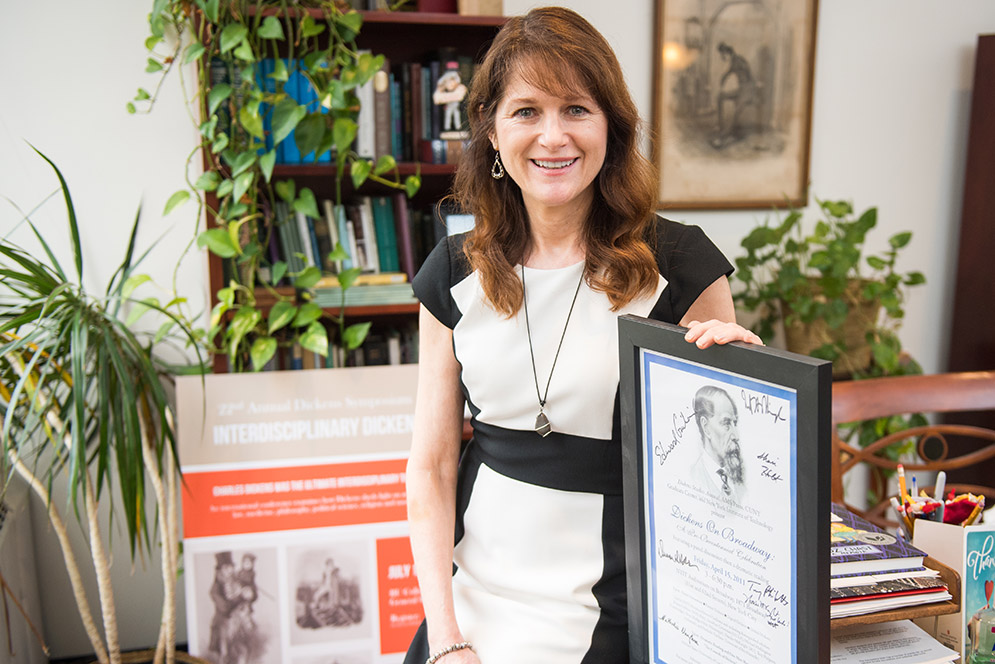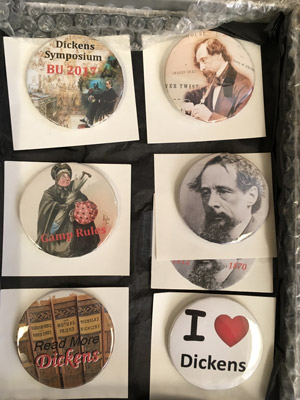Please, Sir, I Want Some More Textual Analysis
Dickens conference at CGS tackles linguistics, stage vampires, disease, more

Natalie McKnight, dean of the College of General Studies and a Charles Dickens scholar, is the host of this weekend’s annual Dickens Symposium, cosponsored by the Dickens Society and the Center for Interdisciplinary Teaching & Learning at CGS. Photo by Cydney Scott
Rumty iddity, row dow dow.
Sing toodlely, teedlely, bow wow wow.
The bit of doggerel that introduces a character named Bella Wilfer in Charles Dickens’ Our Mutual Friend might seem to be nothing more than poetic nonsense. But in a paper being delivered at this weekend’s Interdisciplinary Dickens, the 22nd annual Dickens Symposium, New York high school teacher and independent scholar Dano Cammarota argues that the verse offers an important signpost to Dickens’ understanding of linguistic science, which was emerging in the scientific and intellectual ferment of 1860s England.
That’s right. Dickens attended at least one of three lectures given at the Royal Institution of Great Britain at Oxford by linguist Max Muller, who proposed that language develops not from authorities on high but via an injection of words and sounds from “the lower and popular strata of speech.” Simply put, from the street—a concept that would have appealed to the populist Dickens. Cammarota’s paper, “Bow Wow Wow & Quack Quack: The Language of Dickens in Our Mutual Friend and Martin Chuzzlewit,” demonstrates how the author’s interest in this emerging science clearly makes its way into his novels.
If you think of Charles Dickens (1812–1870) as merely the creator of appealing urchins like Oliver Twist and Tiny Tim, you had best think again. The English novelist and journalist cast an extraordinarily wide net across society, thanks to his natural curiosity and his drive to accurately depict the struggles of his fellow human beings. That breadth is on display at the symposium, being held July 14 to 16 at the College of General Studies, cosponsored by the international Dickens Society and the Center for Interdisciplinary Teaching & Learning at CGS.

“Dickens is someone, like Shakespeare, who has encyclopedic knowledge and chronicles people from all walks of life and all parts of society,” says Dickens scholar and symposium host Natalie McKnight, dean of CGS. “There isn’t much you could be interested in, in terms of a discipline, that you couldn’t find some angle on in Dickens.”
Or at the symposium. The dozens of papers being presented range from the psychologically minded “Down the Hatch: David Copperfield and Mouth Fetish” to “Back to the Future: Charles Dickens, Neuroscience, and the Brain.” In “Dickens and Vampire Melodrama; or, The Real Mystery of John Jasper,” April Nixon Kendra, a University of Delaware assistant professor of English, argues that the “enigmatic choirmaster” central to Dickens’ unfinished The Mystery of Edwin Drood has much in common with the vampires in two popular stage melodramas of Dickens’ day.
“As is always the case with this conference, the program is testimony to the extraordinary multitudes that Dickens contains,” says Iain Crawford, a University of Delaware associate professor of English and Dickens Society president.
Consider “Wee Beasties: Dickens, Microbes, and Bleak House,” by Andre DeCuir, a Muskingum University associate professor of English, and his friend Shawn Blohm, a biologist with the US Army Corp of Engineers. Bleak House is almost obsessed with water, they write, and Dickens may have been ahead of his time in sensing that contaminated water, rather than “the stench of decay,” was responsible for the transmission of disease.
All of which illustrates Dickens’ passionate concern for social justice, from the microscopic to the macro view. “The divide between the rich and the poor today, we know is getting wider and wider, and it’s something Dickens saw and wrote about,” says McKnight. “A lot of authors today don’t take on social issues because they’re afraid of seeming too preachy or something. But in his day, that was maybe more accepted, and certainly he made it acceptable because he made it entertaining, too.”
In Bleak House, he did that with the character Jo, a homeless orphan who makes his living as a crossing sweep, brushing away the mud and dirt in front of high-class ladies and gentlemen so their shoes and hems don’t get dirty. Jo is the lowest of the low, and he contracts smallpox and spreads it right up the social ladder, because germs don’t know who you are and don’t really care if you’re important or have a lot of money.
“That’s one of the things that Dickens is trying to point out,” McKnight says, “that there’s this huge divide between the people at the top and the people at the bottom, and yet his brilliant insight is that the top and the bottom are deeply connected in ways you may not like, and if you don’t take care of the bottom, it will end up badly at the top.”
Comments & Discussion
Boston University moderates comments to facilitate an informed, substantive, civil conversation. Abusive, profane, self-promotional, misleading, incoherent or off-topic comments will be rejected. Moderators are staffed during regular business hours (EST) and can only accept comments written in English. Statistics or facts must include a citation or a link to the citation.